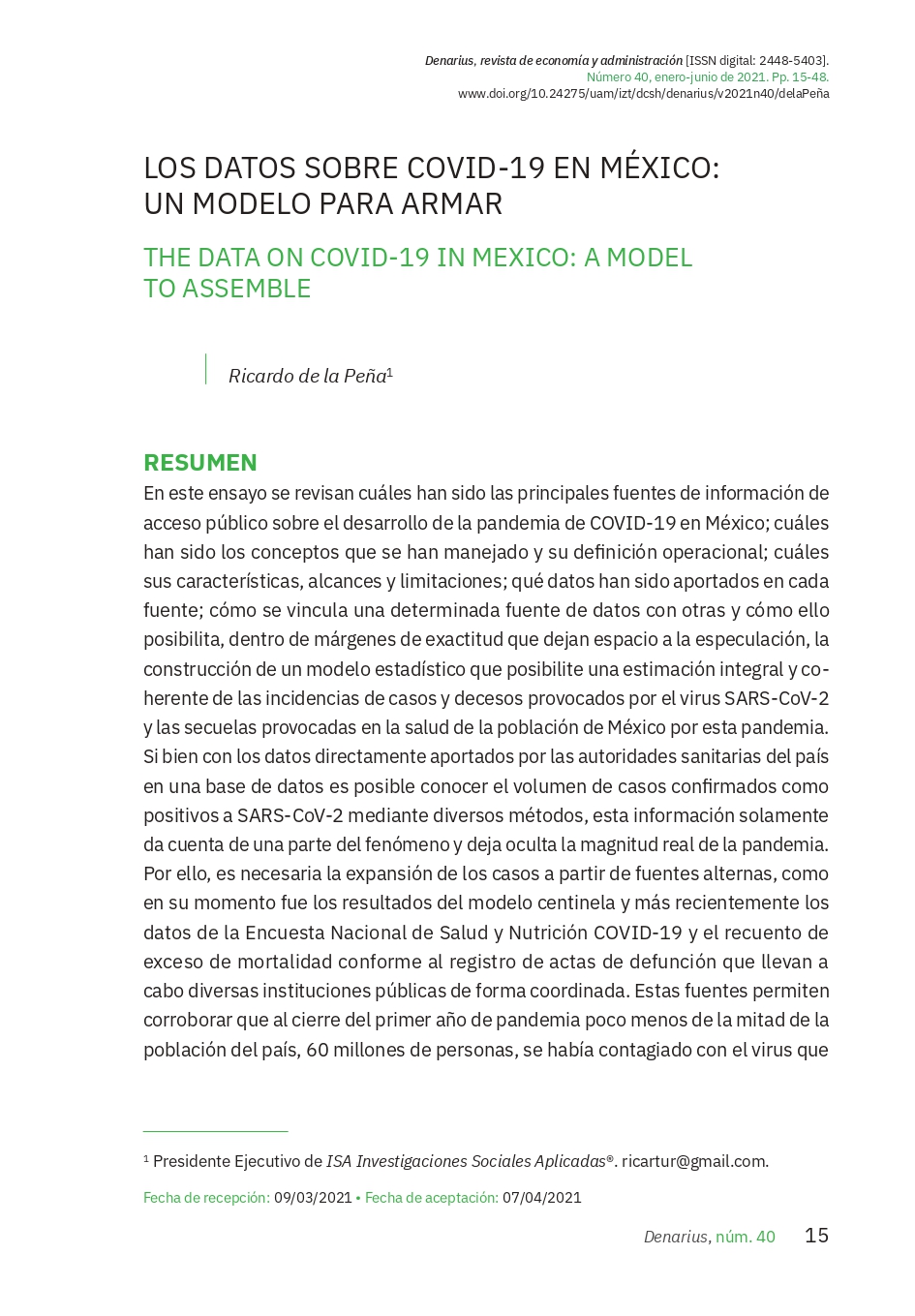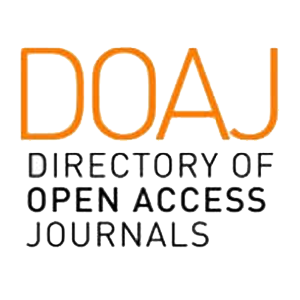The Data On COVID-19 In Mexico: A Model To Assemble
Abstract
This essay reviews the main sources of public access information on the development of the COVID-19 pandemic in Mexico; what have been the concepts they have handled and their operational definition; what its characteristics, scope and limitations; what data has been provided in each source; how a certain data source is linked with others and how this makes it possible, within accuracy margins that leave space for speculation, the construction of a statistical model that enables a comprehensive and coherent estimation of the incidents of cases and deaths caused by the SARS-CoV-2 virus and the consequences caused in the health of the population of Mexico by this pandemic. Although with the data directly provided in a database by the health authorities of the country it is possible to know the volume of cases confirmed as positive for SARS-CoV-2 through various methods, this information only accounts for part of the phenomenon and leaves hides the real magnitude of the pandemic. Therefore, the expansion of cases from alternative sources is necessary, as at the time was the results of the sentinel model and more recently the data from the National Survey of Health and Nutrition COVID-19 and the count of excess mortality according to the registration of death certificates carried out by various public institutions in a coordinated manner. These sources allow corroborating that at the close of the first year of the pandemic, just under half of the country’s population, 60 million people, had been infected with the virus that causes COVID-19 and the volume of deaths added to normal reached almost
300 thousand people.
Downloads
References
Castañeda, A. y Garrido, S. (2021). “¿Cómo entender los datos de defunciones por COVID-19 en México?”. En: Nexos, 19 de mayo. Disponible en: https://datos.nexos.com.mx/ ?p=1351. Consultado el 6 de marzo de 2021.
Diéguez, A. (2017). “Modelos falsos en la ciencia: un valioso recurso para la comprensión de los fenómenos”. En: Metatheoria, 8(1), 95-105. Disponible en RIDAA-UNQ Repositorio Institucional Digital de Acceso Abierto de la Universidad Nacional de Quilmes. Disponible en: http://ridaa.unq.edu.ar/handle/20.500.11807/2500. Consultado el 6 de marzo de 2021.
Elgin, C.Z. (2009). “Is Understanding Factive?”. En: Haddock, A., Millar, A. y Pritchard, D. (eds.), Epistemic Value. Oxford University Press.
Instituto Nacional de Estadística y Geografía. (2021). Censo de Población y Vivienda 2020. Disponible en: https://www.inegi.org.mx/programas/ccpv/2020/. Consultado el 6 de marzo de 2021.
Maimon, O. y Rokach, L. (2010). Data Mining and Knowledge Discovery Handbook. Springer, New York. Disponible en: https://www.researchgate.net/publication/236005657_Data_Mining_and _Knowledge_Discovery_Handbook_2nd_ed. Consultado el 6 de marzo de 2021.
Organización Mundial de Salud. (2020a). Nuevo coronavirus – China, 12 de enero. Disponible en: https://web.archive.org/web/20200121045901/https://www.who.int/ csr/don/12-january-2020-novel-coronavirus-china/es/. Consultado el 6 de marzo de 2021.
-----. (2020b). Definiciones de casos de vigilancia de la OMS para ILI y SARI. Disponible en: https://www.who.int/influenza/surveillance_monitoring/ili_sari_surveillance _case_definition /en/. Consultado el 6 de marzo de 2021.
Organización Panamericana de la Salud y Organización Mundial de la Salud. (2014). Guía operativa para la vigilancia centinela de la Infección Respiratoria Aguda Grave (IRAG), septiembre. Disponible en: https://www.paho.org/revelac-i/wp-content/uploads/2015/10/ 2015-cha-guia-operativa-vigilancia-centinela-irag.pdf. Consultado el 6 de marzo de 2021.
Real Academia Nacional de Medicina (2012). Diccionario de términos médicos.
Ritchie, H., Roser, M. Ortiz-Espina, E. y Hasell, J. (2020). “Excess mortality from the Coronavirus pandemic (COVID-19)”. Disponible en: https://ourworldindata.org/ coronavirus. Consultado el 6 de marzo de 2021
Secretaría de Salud. (2020a). Comunicado_Técnico_Diario_2019nCoV_2020.01.22, 22 de febrero. Disponible en: https://www.gob.mx/cms/uploads/attachment/file/571450/
Comunicado_Tecnico_Diario_2019nCoV_2020.01.22.pdf. Consultado el 6 de marzo de 2021.
-----. (2020b). Datos Abiertos Dirección General de Epidemiología. Disponible en: https://www.gob.mx/salud/documentos/datos-abiertos-152127. Consultado el 6 de marzo de 2021.
-----. (2020c). Conferencia de Prensa del Gobierno de México sobre COVID-19. 3 de junio. Disponible en: https://www.youtube.com/watch?v=3HSlWfe8LQI. Consultada el 6 de marzo de 2021.
----. (2020d). Lineamiento estandarizado para la vigilancia epidemiológica y por laboratorio de la enfermedad respiratoria viral. Abril. Disponible en: https://coronavirus.gob.mx/wp-content/uploads/2020/04/Lineamiento_de_vigilancia _epidemiologica_de_enfermedad_respiratoria-_viral.pdf. Consultado el 6 de marzo de 2021.
-----. (2020e) Comunicado oficial. 24 de agosto. Disponible en: https://www.gob.mx/ cms/uploads/attachment/file/573732/Comunicado_Oficial_DOC_sospechoso_ERV_240820.pdf. Consultado el 6 de marzo de 2021.
-----. (2020f). Manual para la vigilancia epidemiológica de influenza. Octubre. Disponible en: http://187.191.75.115/gobmx/salud/documentos/manuales/12_Manual_VE _Influenza. pdf. Consultado el 6 de marzo de 2021.
-----. (2020g). Aviso Epidemiológico (CONAVE /09/ 2020/COVID-19). 6 de abril. Disponible en: https://www.gob.mx/cms/uploads/attachment/file/545445/AE_Enfermedad_ COVID-19_SARS-CoV-2_2020.04.06.pdf. Consultado el 6 de marzo de 2021.
-----. (2020h). Conferencia de prensa sobre COVID-19. 15 de diciembre. Disponible en: https://www.youtube.com/watch?v=wCihXQmT2rc. Consultado el 6 de marzo de 2021.
-----. (2021). Exceso de mortalidad por todas las causas durante la emergencia por COVID-19 en México. 2 de enero. Disponible en: https://coronavirus.gob.mx/exceso-de-mortalidad-en-mexico/. Consultado el 6 de marzo de 2021.
Wittgenstein, L. (1963). Tractatus logico-philosophicus: Logisch-philosophische Abhandlung. Suhrkamp Verlag.














